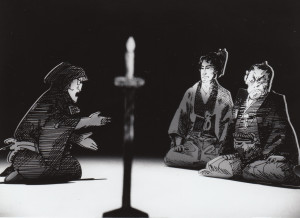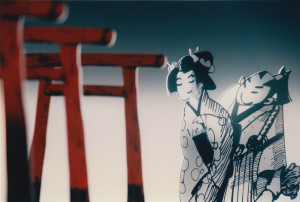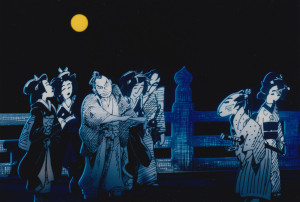Shinsengumi
June 14, 2015 · 0 comments
By Jasper Sharp.

The Shinsengumi was a self-appointed law-enforcing militia loyal to the Tokugawa shogunate that emerged in Kyoto during the Bakumatsu era of the 1860s. At its peak numbering around 300 members, it appeared at a turbulent time in the nation’s history. The whole feudal applecart was on the cusp of overturning following the arrival of Commodore Perry’s “black ships” on the horizon in 1854 seeking to break open Japan’s trade barriers after 300-years of self-imposed isolation. Meanwhile there were other internal ruptures within the social fabric, namely the breakaway anti-shogunate groups of the Choshu and Satsuma clans, keen to push the country into a new age.
Of course, Japan did end up opening up to the rest of the world, the Imperial line was restored and the old bakufu system of military governance dismantled, so it is pretty safe to say in hindsight that this band of ultra-conservative reactionaries was on the wrong side of history (although there have been plenty over the past 150 years who would rather the country retreated back into the cosy nostalgia of Tokugawa nationalism). Certainly the glorious age of the samurai came to a gruesome end for most of the Shinsengumi’s key figures – in blood, sweat, tears and ritual-disembowelment.
 But whether one views its members as “either Japan’s last bastion of samurai virtue or a group of bigoted vigilantes who terrorized Kyoto until torn apart by internal rivalries” – as Jonathan Clements and Motoko Tamamuro frame them in their review of Asahi TV’s 1998 Shinsengumi series in The Dorama Encyclopedia: A Guide to Japanese TV Drama Since 1953 – one can’t deny that the group’s formation and implosion at this crucial juncture in Japanese history and the larger than life players at the heart of the story don’t half make for a ripping good yarn.
But whether one views its members as “either Japan’s last bastion of samurai virtue or a group of bigoted vigilantes who terrorized Kyoto until torn apart by internal rivalries” – as Jonathan Clements and Motoko Tamamuro frame them in their review of Asahi TV’s 1998 Shinsengumi series in The Dorama Encyclopedia: A Guide to Japanese TV Drama Since 1953 – one can’t deny that the group’s formation and implosion at this crucial juncture in Japanese history and the larger than life players at the heart of the story don’t half make for a ripping good yarn.
From the 1920s onwards, there have been dozens of novels, films, TV series, manga, computer games and anime based around the exploits and power jostles of commanders Isami Kondo, Toshizo Hijikata and Keisuke Yamanami et al. In the world of cinema, the best-known internationally is probably Nagisa Oshima’s Gohatto (1999; a.k.a. Taboo). In anime, we’ve had the comic spin of the 1989 video Shinsengumi Farce and the time-travelling historical mash-up of Zeguy (1992) – but nothing really in the way of faithful recreation of who or what the Shinsengumi actually were, nor any real analysis of what they stood for then and what they mean now. Until…
It is funny to talk of an International Premiere for a film that is already 15 years old, but this was exactly the status of the screening of Kon Ichikawa’s Shinsengumi in a brand-new English-subtitled digital print at Frankfurt’s Nippon Connection festival on 5th June 2015. Produced for Fuji TV, the film received a very limited theatrical release in Japan in 2000 (opening in Tokyo’s Eurospace cinema) before airing more widely on television. However, until now, it has never been shown overseas.
 It is equally odd to think of the film in terms of ‘anime’. It is certainly animation in its broadest sense, although the style stretches the definition of the medium about as far as it goes – at least in our conventional screen-based understanding of the word. Inspired by the kamishibai (“paper theatre”) form of storytelling that Japanese kids growing up in the early half of the 20th century would have been familiar with, it uses a technique known as tachi-e, with flat, cardboard cut-outs on sticks operated like live-action puppets on a miniature stage,
It is equally odd to think of the film in terms of ‘anime’. It is certainly animation in its broadest sense, although the style stretches the definition of the medium about as far as it goes – at least in our conventional screen-based understanding of the word. Inspired by the kamishibai (“paper theatre”) form of storytelling that Japanese kids growing up in the early half of the 20th century would have been familiar with, it uses a technique known as tachi-e, with flat, cardboard cut-outs on sticks operated like live-action puppets on a miniature stage,
Shinsengumi also deploys the whole arsenal of basic film techniques – fast cuts, dramatic dissolves, pans across still images, superimpositions and lighting effects – so that even when nothing is really moving, the scene as a whole comes across as fairly dynamic. Nagisa Oshima opted for a similar tack with Band of Ninja (1967; a.k.a. Manual of Ninja Martial Arts), revived for last year’s Nippon Connection – essentially making a dramatic film by directly filming the individual frames of an original manga by Shirato Sanpei and adding voice performances and sound effects (incidentally, Mamoru Sasaki, Oshima’s regular screenwriter during the 1960s, scripted both these works).
Whether one can describe such an approach as animation depends on where exactly one draws the line between what is done in front of the camera and what is done with the camera (or at the editing desk). With Shinsengumi and Band of Ninja, the end results aren’t actually that far removed from the limited animation techniques pioneered by Osamu Tezuka for his original Astro Boy TV series in 1962 which, more by financial necessity than aesthetic choice, has been the dominant style for much of anime’s history.
 Perhaps the relative obscurity of Shinsengumi is less down to the means and methods of its making than the fact that its director, Kon Ichikawa, is far better known for his live-action films – and particularly for the type of critically-exalted, classical arthouse work whose devotees would perhaps view animation as belonging to an entirely different world to that of cinema proper. Titles such as Conflagration (1958), Fires on the Plain (1959) and An Actor’s Revenge (1963) are seen as landmark titles from Japanese cinema’s late Golden Age, while Tokyo Olympiad, his 170-minute documentary of the 1964 Tokyo Olympics, swiftly became the top-grossing domestic title of all time upon its release.
Perhaps the relative obscurity of Shinsengumi is less down to the means and methods of its making than the fact that its director, Kon Ichikawa, is far better known for his live-action films – and particularly for the type of critically-exalted, classical arthouse work whose devotees would perhaps view animation as belonging to an entirely different world to that of cinema proper. Titles such as Conflagration (1958), Fires on the Plain (1959) and An Actor’s Revenge (1963) are seen as landmark titles from Japanese cinema’s late Golden Age, while Tokyo Olympiad, his 170-minute documentary of the 1964 Tokyo Olympics, swiftly became the top-grossing domestic title of all time upon its release.
Nevertheless, Ichikawa’s career actually began in the field of animation. Born in 1915, he studied the fine arts and, inspired by the works of Disney, joined the animation department of J.O. Studios in Kyoto in the mid-1930s, which in 1937 became part of the new company Toho. His first work, A Girl at Dojo Temple (1945), a 20-minute live-action puppet adaptation of a Kabuki play, was filmed during the final years of the war. However, it was never actually released in Japan as its “traditional” feudal subject matter saw it banned by the Occupation authorities. The film was long believed lost, although a print was discovered relatively recently at the Cinémathèque Française in Paris (and is already on Youtube).
Ichikawa later returned to live-action puppetry with the quite frankly bizarre international co-production Topo Gigio and the Missile War (1967), which pitted a talking mouse popular on Italian children’s television against human actors to put across its antiwar message.
 Ichikawa’s puppet animations, like Shinsengumi, however, remain all but invisible within a massive body of work realised across a staggering 60+ years and crammed with big-budget prestige pictures and classic literary adaptations like Harp of Burma (1956; remade by the director in 1985) and The Makioka Sisters (1983). Even in its own year of release, Shinsengumi was overshadowed by the director’s Dora-Heita (2000), a historical drama starring Koji Yakusho and based on a script written decades previously for the “Four Knights Group”, the independent production company formed by Ichikawa with his contemporaries Akira Kurosawa, Masaki Kobayashi and Keisuke Kinoshita. Ichikawa was active almost right up to his death in 2008, with his final film a 30th-anniversary remake of his own The Inugami Family (1976) released in 2006. By the time he’d passed away, aged 92, he’d put his name to almost a hundred titles.
Ichikawa’s puppet animations, like Shinsengumi, however, remain all but invisible within a massive body of work realised across a staggering 60+ years and crammed with big-budget prestige pictures and classic literary adaptations like Harp of Burma (1956; remade by the director in 1985) and The Makioka Sisters (1983). Even in its own year of release, Shinsengumi was overshadowed by the director’s Dora-Heita (2000), a historical drama starring Koji Yakusho and based on a script written decades previously for the “Four Knights Group”, the independent production company formed by Ichikawa with his contemporaries Akira Kurosawa, Masaki Kobayashi and Keisuke Kinoshita. Ichikawa was active almost right up to his death in 2008, with his final film a 30th-anniversary remake of his own The Inugami Family (1976) released in 2006. By the time he’d passed away, aged 92, he’d put his name to almost a hundred titles.
Shinsengumi might not stand out alongside Ichikawa’s best-known works. The large parade of (dare I say it) 2-dimensional caricatures of real-life historical figures who would be familiar to Japanese viewers, the sheer density and complexity of plotting, and the overall historical context, might prove a little overwhelming for foreign viewers coming at the film with no prior knowledge. Nevertheless, its existence not only points towards the diverse scope of Ichikawa’s own oeuvre, but as evidence of the vast array of techniques used by Japanese animators outside of anime’s core culture.
Jasper Sharp is the author of The Historical Dictionary of Japanese Cinema.
Jasper Sharp
Leave a Reply